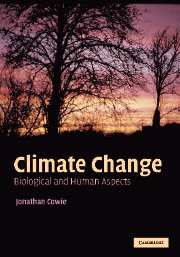Book contents
- Frontmatter
- Contents
- Introduction
- Acknowledgements
- 1 An introduction to climate change
- 2 Principal indicators of past climates
- 3 Past climate change
- 4 The Oligocene to the Quaternary: climate and biology
- 5 Present climate and biological change
- 6 Current warming and likely future impacts
- 7 The human ecology of climate change
- 8 Sustainability and policy
- Appendix 1 Glossary and abbreviations
- Appendix 2 Bio-geological chronology
- Appendix 3 Calculations of energy demand/supply and orders of magnitude
- Appendix 4 The IPCC 2007 report
- Index
- References
1 - An introduction to climate change
Published online by Cambridge University Press: 17 December 2010
- Frontmatter
- Contents
- Introduction
- Acknowledgements
- 1 An introduction to climate change
- 2 Principal indicators of past climates
- 3 Past climate change
- 4 The Oligocene to the Quaternary: climate and biology
- 5 Present climate and biological change
- 6 Current warming and likely future impacts
- 7 The human ecology of climate change
- 8 Sustainability and policy
- Appendix 1 Glossary and abbreviations
- Appendix 2 Bio-geological chronology
- Appendix 3 Calculations of energy demand/supply and orders of magnitude
- Appendix 4 The IPCC 2007 report
- Index
- References
Summary
In most places on this planet's terrestrial surface there are the signs of life. Even in those places where there is not much life today, there are frequently signs of past life, be it fossils, coal or chalk. Further, it is almost a rule of thumb that if you do discover signs of past life, either tens of thousands or millions of years ago, then such signs will most likely point to different species to those found there today. Why? Here there are a number of answers, not least of which is evolution. Yet a key feature of why broad types of species (be they broad-leaved tree species as opposed to narrow needle-leaved ones) live in one place and not another is to do with climate. Climate is a fundamental factor influencing biology. Consequently a key factor (among others) as to why different species existed in a particular place 5000, 50 000, 500 000 or even 5 000 000 years ago (to take some arbitrary snapshots in time) is due to different climatic regimens existing at that place in those times.
It is also possible to turn this truism on its head and use biology to ascertain aspects of the climate, and biological remains are aspects of past climates. Furthermore, biology can influence climate: for example, an expanse of rainforest transpires such a quantity of water, and influences the flow of water through a catchment area, that it can modify the climate from what it otherwise would have been in the absence of living species.
- Type
- Chapter
- Information
- Climate ChangeBiological and Human Aspects, pp. 1 - 36Publisher: Cambridge University PressPrint publication year: 2007



